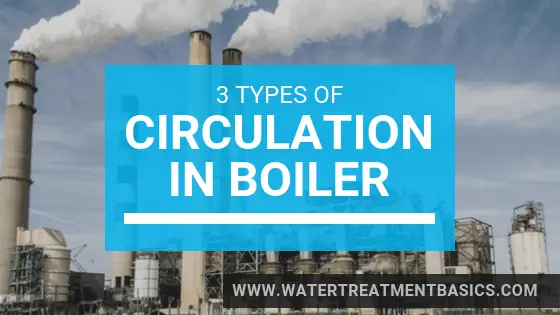Circulation in Boiler:
Types of water circulation in industrial steam water tube boilers:
Water circulation in boiler can be classified in three different types of systems.
- Natural Circulation
- Controlled Circulation
- Combined Circulation
#1.Natural Circulation In Boiler:
Boiler feed water which is pumped with high pressure boiler feed water pumps first reaches at economizer. Here temperature of the boiler feed water is around the saturation temperature corresponding to its pressure.
Saturation temperature means the temperature at which water vaporization is starts for a given pressure. It is also called the boiling point of water. Feed water flows through economizer gets further heated by flue gas and enters into the steam drum. Steam drum acts as a pressure vessel and separates steam and water from steam water mixture.
Normally steam drum water level is maintained around 50%.It means steam drum is half filled with water & remaining 50% above the water level contains steam. Water inside the drum flows down through down comer pipes and distributed by bottom header to water walls.
Down comer pipes are outside the boiler furnace while water walls are inside the furnace. Water rises through water wall tubes are exposed to furnace heat. When water rises upside in tubes, a portion of the water is converted into steam and continue to rise upwards as a mixture of steam and water.
Heat absorbed in water wall is latent heat of vaporization creating a mixture of steam and water.
The ratio of the weight of water to the weight of steam in the mixture leaving the heat absorption surface is called circulation ratio. This mixture is continuously rises till it reaches back to the steam drum. Separated steam from steam drum is sent to the turbine.
The value of circulation ratio varies from 6 to 30 in industrial boilers. Circulation ratio for utility high pressure boilers is between 6 to 9. Circulation ratio is higher side as the density difference between steam & water is high.
Medium pressure industrial boilers adopted higher circulation ratio. These boilers have to respond quick load changes.
The circulation, in this case, takes place on the basis of thermo-siphon principle. The Down comer contains relatively cold water, whereas the riser tubes contain a steam & water mixture, whose density is comparatively less.
This density difference is the driving force, for the mixture. Circulation takes place at such a rate that the driving force and frictional resistance are balanced.
As the pressure increases, the difference in density between water and steam decreases. Thus the hydrostatic head available will not be able to overcome the frictional resistance for a flow corresponding to the minimum requirement of cooling of water wall tubes.
Therefore natural circulation is limited to boiler with drum operating pressure around 175 kg/cm2.
#2.Controlled Circulation In Boiler:
If the Operating pressure of boiler is between 180 kg/cm2 to 200 kg/cm2 then circulation in boiler is to be assisted with mechanical pumps, to overcome frictional losses. To regulate the flow through various tubes, orifice plates are used.
#3.Combined Circulation In Boiler:
This circulation in boiler is applicable to the boilers which are operating at critical pressure. In this system phase transformation is absent means water is directly converted into the steam at these pressure and temperature. Generally, operating pressure of this system is 260 Kg/cm2
